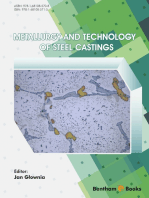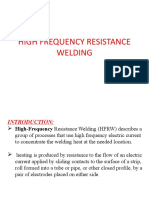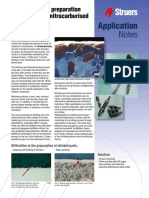Surface Treatments
Surface Treatments
Uploaded by
Vaibhav GuptaCopyright:
Available Formats
Surface Treatments
Surface Treatments
Uploaded by
Vaibhav GuptaOriginal Description:
Copyright
Available Formats
Share this document
Did you find this document useful?
Is this content inappropriate?
Copyright:
Available Formats
Surface Treatments
Surface Treatments
Uploaded by
Vaibhav GuptaCopyright:
Available Formats
Surface Treatments
SUBMITTED TOMAMTA SHARMA
SUBMITTED BYPULKIT AGRAWAL
11108028
Introduction
Surface Treatments
Why?
Types
Cleaning
Mechanical Measurements
Standards
Types
Dimensioning
Why use a surface treatment?
Improves
durability
Controls Friction
Reduces Adhesion
Why use surface treatment? (cont)
Improves
Lubrication
Rebuild Surfaces
Aesthetics
Types of Treatments
Mechanical Surface Treatments
Mechanical Plating & Cladding
Case Hardening
Thermal Spraying
Vapor Deposition
Laser Treatments
Mechanical Surface Treatments
Peening
Shot Peening
Laser Shot Peening
Water-jet Peening
Ultrasonic Peening
Roller Burnishing
Explosive
Hardening
Mechanical Plating & Cladding
Mechanical Plating
Cladding
Laser Cladding
Case Hardening and Hard Facing
Case Hardening
Hard Facing
Spark Hardening
Thermal Spraying
Combustion
Spraying
Thermal Wire
Spray
Thermal MetalPowder Spray
Plasma Spray
Electroplating, Electroless Plating,
and Electroforming
Electroplating
Workpiece (cathode) is
plated with other metal
(anode) through a
water-based
electrolytic solution
A SLOW Process!!!
75 micrometers/hour
Solution must be
replenished
Sacrificial anode
Additional salts of
metal
Electroplating, Electroless Plating,
and Electroforming
Electroless Plating
Chemical Reaction
More Expensive $$
Uniform Thickness
Electroforming
Metal-fabrication
Metal electrodeposited
on a mandrel
Conversion Coatings
Anodizing
The workpiece is
the anode in an
electrolytic cell
Coloring
Alters color of
metals, alloys, and
ceramics
Conversion of
surfaces into
chemical
compounds:
oxides, chromates,
and phosphates
Hot Dipping
Workpiece is dipped
into molten metal
Zinc- galvanized-steel
sheet
Tin- food containers
Hot-dipped Galvanizing
line
Surface Texturing & Painting
Texturing Techniques
Etching
Electric Arcs
Lasers
Atomic oxygen
Paint Classification
Enamels
Lacquers
Water-based paints
Cleaning of Surfaces
3 types
Mechanical Cleaning
Electrolytic Cleaning
Physically disturb
contaminants
Abrasive bubbles aid
in contaminant
removal
Chemical Cleaning
Solution
Saponification
Emulsification
Dispersion
Aggregation
You might also like
- CH 10Document31 pagesCH 10fateh mehmoodNo ratings yet
- Composition of Steels PDFDocument5 pagesComposition of Steels PDFNitin SharmaNo ratings yet
- Welding and Types of WeldingDocument9 pagesWelding and Types of WeldingMunem ShahriarNo ratings yet
- Friction Stir Welding ReportDocument16 pagesFriction Stir Welding ReportjishnuNo ratings yet
- Metal Joining Processes: Prof. Mayur S Modi Assistant Professor Mechanical Engineering Department Ssasit, SuratDocument79 pagesMetal Joining Processes: Prof. Mayur S Modi Assistant Professor Mechanical Engineering Department Ssasit, SuratPrateekNo ratings yet
- Heat TreatmentDocument24 pagesHeat TreatmentOlanrewaju Slyman Damilola100% (1)
- METALSDocument48 pagesMETALSMian Afzaal 72No ratings yet
- Optimization of Submerged Arc WeldingDocument4 pagesOptimization of Submerged Arc WeldingricardoNo ratings yet
- 2-3 Diffusion WeldingDocument40 pages2-3 Diffusion WeldingDanny Vargas HuamanNo ratings yet
- Chapter2 - AJMDocument13 pagesChapter2 - AJMravish kumarNo ratings yet
- A Review Paper On Effect of Input Welding Process Parameters On Structures and Properties of Weld in Submerged Arc Welding ProcessDocument5 pagesA Review Paper On Effect of Input Welding Process Parameters On Structures and Properties of Weld in Submerged Arc Welding ProcessZarif YusufNo ratings yet
- MCM AllDocument7 pagesMCM AllPalanisamy RajaNo ratings yet
- Cutting Tool Materials SeminarDocument21 pagesCutting Tool Materials SeminarSahad MkNo ratings yet
- EBWDocument21 pagesEBWbathinsreenivasNo ratings yet
- Chapter 4 - MATERIAL TESTINGDocument48 pagesChapter 4 - MATERIAL TESTINGتاج نيسهاNo ratings yet
- MMS Unit IVDocument4 pagesMMS Unit IVAdula RajasekharNo ratings yet
- Effect of Niobium On The As-Cast Microstructure of Hypereutectic High Chromium Cast IronDocument4 pagesEffect of Niobium On The As-Cast Microstructure of Hypereutectic High Chromium Cast IronMatheus BoligonNo ratings yet
- Design of Gating and Feeding Systems: Experiment SixDocument12 pagesDesign of Gating and Feeding Systems: Experiment SixArvie PutriNo ratings yet
- High Frequency Resistance WeldingDocument23 pagesHigh Frequency Resistance WeldingAnonymous cgcKzFtXNo ratings yet
- Exp 4Document11 pagesExp 4masuma lovelyNo ratings yet
- Metallography and Heat Treatment - Lab ReportDocument14 pagesMetallography and Heat Treatment - Lab ReportBrendan Jones0% (1)
- PART 166 What Is Spot WeldingDocument4 pagesPART 166 What Is Spot Weldingravindra_jivaniNo ratings yet
- Continuous Casting Defects: Origins and Control: Prof. Viswanathan N N Indian Institute of Technology - BombayDocument32 pagesContinuous Casting Defects: Origins and Control: Prof. Viswanathan N N Indian Institute of Technology - Bombayamit gajbhiyeNo ratings yet
- MP Lecture Unit 3 FormingDocument21 pagesMP Lecture Unit 3 Formingaakash sharmaNo ratings yet
- Arc Welding Types MP IIDocument40 pagesArc Welding Types MP IISyedUbaidRehman100% (1)
- Material ProcessingDocument8 pagesMaterial ProcessingioanapanaitNo ratings yet
- Ultrasonic Welding PDFDocument43 pagesUltrasonic Welding PDFsanmiteNo ratings yet
- Continuous Casting of Aluminum Based Bearing Alloys Subs Tech)Document5 pagesContinuous Casting of Aluminum Based Bearing Alloys Subs Tech)Carlos LorenzanaNo ratings yet
- Bar Basics and TerminologyDocument24 pagesBar Basics and TerminologyEdwin MPNo ratings yet
- Bulk Deformatin Processes and EquipmentDocument46 pagesBulk Deformatin Processes and EquipmentarhlboyNo ratings yet
- Wear Analysis of Hard Faced Agricultural Equipment - Doc FFDocument15 pagesWear Analysis of Hard Faced Agricultural Equipment - Doc FFSunil BasavarajuNo ratings yet
- Welding DistortionDocument7 pagesWelding DistortionSreejith S NairNo ratings yet
- MCL-135-Welding and Allied Processes - Class 11-15Document58 pagesMCL-135-Welding and Allied Processes - Class 11-15mHmNo ratings yet
- Ezz Steel Long Products BrochureDocument41 pagesEzz Steel Long Products BrochureAyman El Kateb100% (2)
- A Project Report On Cost Reduction in Melting - A SQC and Six Sigma ApproachDocument107 pagesA Project Report On Cost Reduction in Melting - A SQC and Six Sigma ApproachArun Prince100% (1)
- WeldingDocument24 pagesWeldingbhushan wandreNo ratings yet
- Full Text 01Document90 pagesFull Text 01Walid NASRINo ratings yet
- Table For Density of MetalDocument3 pagesTable For Density of Metalmtarunkumar100% (1)
- Experiment No: - 4 Shell Moulding Process AimDocument5 pagesExperiment No: - 4 Shell Moulding Process AimDhananjay Shimpi100% (1)
- Institute of Technology & Management: Unconventional Machining ProcessDocument28 pagesInstitute of Technology & Management: Unconventional Machining ProcessAkash TripathiNo ratings yet
- Micro Welding SagarpptDocument20 pagesMicro Welding SagarpptYash HiragarNo ratings yet
- Metal Surface TreatmentDocument21 pagesMetal Surface TreatmentNilay SarafNo ratings yet
- Defects, Root Causes in Casting Process and Their Remedies: ReviewDocument9 pagesDefects, Root Causes in Casting Process and Their Remedies: ReviewalliceyewNo ratings yet
- 1 s2.0 S0143974X21002212 MainDocument14 pages1 s2.0 S0143974X21002212 MainRavi PadmanabhanNo ratings yet
- Application Notes Nitrided Coatings EnglishDocument6 pagesApplication Notes Nitrided Coatings EnglishIrina IrinushkaNo ratings yet
- Ch3 - Metal CuttingDocument30 pagesCh3 - Metal Cutting03 ABHISHEK100% (1)
- Resistance WeldingDocument22 pagesResistance WeldingGarden005No ratings yet
- Wire Tube DrawingDocument48 pagesWire Tube DrawingSarthak JadhavNo ratings yet
- Friction WeldingDocument25 pagesFriction WeldingBHAVESH JOSHI0% (1)
- Proses Manufaktur - Fundamental of Metal FormingDocument35 pagesProses Manufaktur - Fundamental of Metal FormingAnatolium IrgrandeNo ratings yet
- Arcelor High Yield IfDocument4 pagesArcelor High Yield IfJayDadrassNo ratings yet
- Methoding Design in Sand Casting HeuristDocument8 pagesMethoding Design in Sand Casting Heuristaciwe aciliwielNo ratings yet
- 2 Classification of Welding PDFDocument31 pages2 Classification of Welding PDFSiva Narendra100% (2)
- Failure Analysis at Deep Drawing of Low Carbon SteelsDocument7 pagesFailure Analysis at Deep Drawing of Low Carbon SteelsPaul RosiahNo ratings yet
- The Light Machine Shop Divided Into The Following SectionDocument5 pagesThe Light Machine Shop Divided Into The Following Sectionyogendra singhNo ratings yet
- Etchant Test On CastingsDocument2 pagesEtchant Test On CastingsHarshaVeeragandhamNo ratings yet
- Lecture 2 - Manufacturing Processes - Fundamentals of Metal Casting and Casting Design - DR Bilal AhmadDocument99 pagesLecture 2 - Manufacturing Processes - Fundamentals of Metal Casting and Casting Design - DR Bilal Ahmadjawad khalidNo ratings yet
- Internship Presentation in Grupo AntolinDocument19 pagesInternship Presentation in Grupo AntolinRavi GowdaNo ratings yet



























































